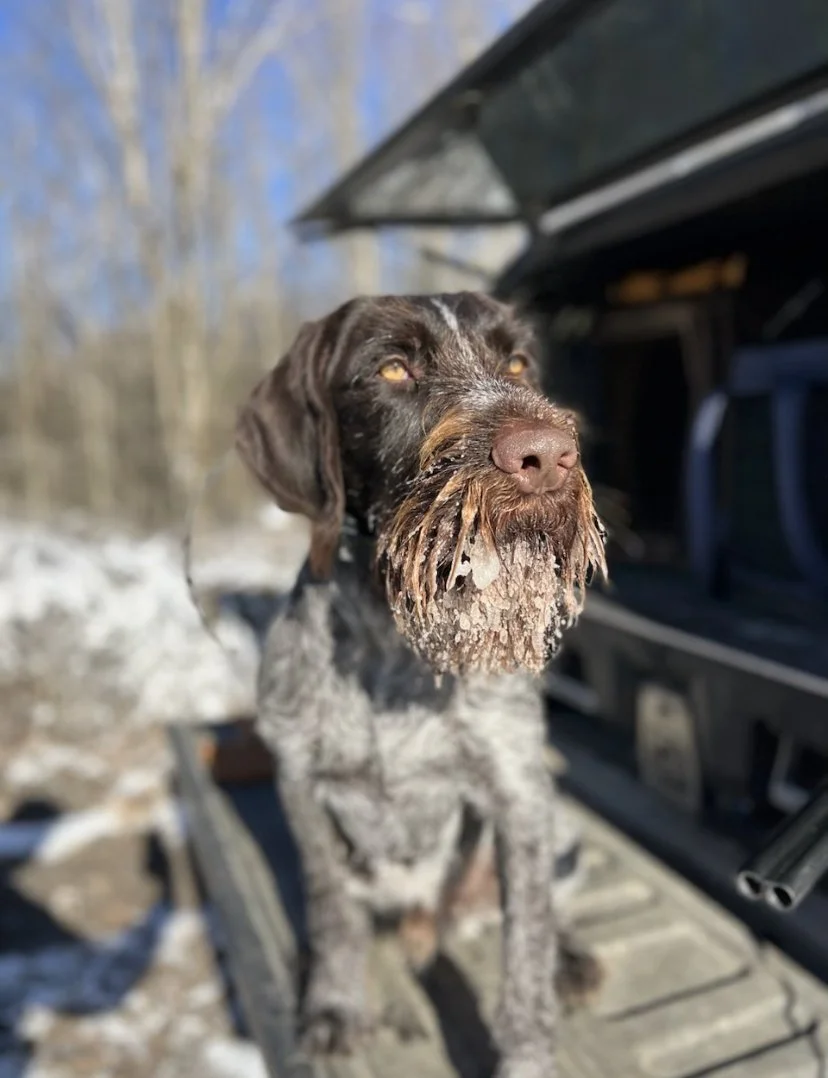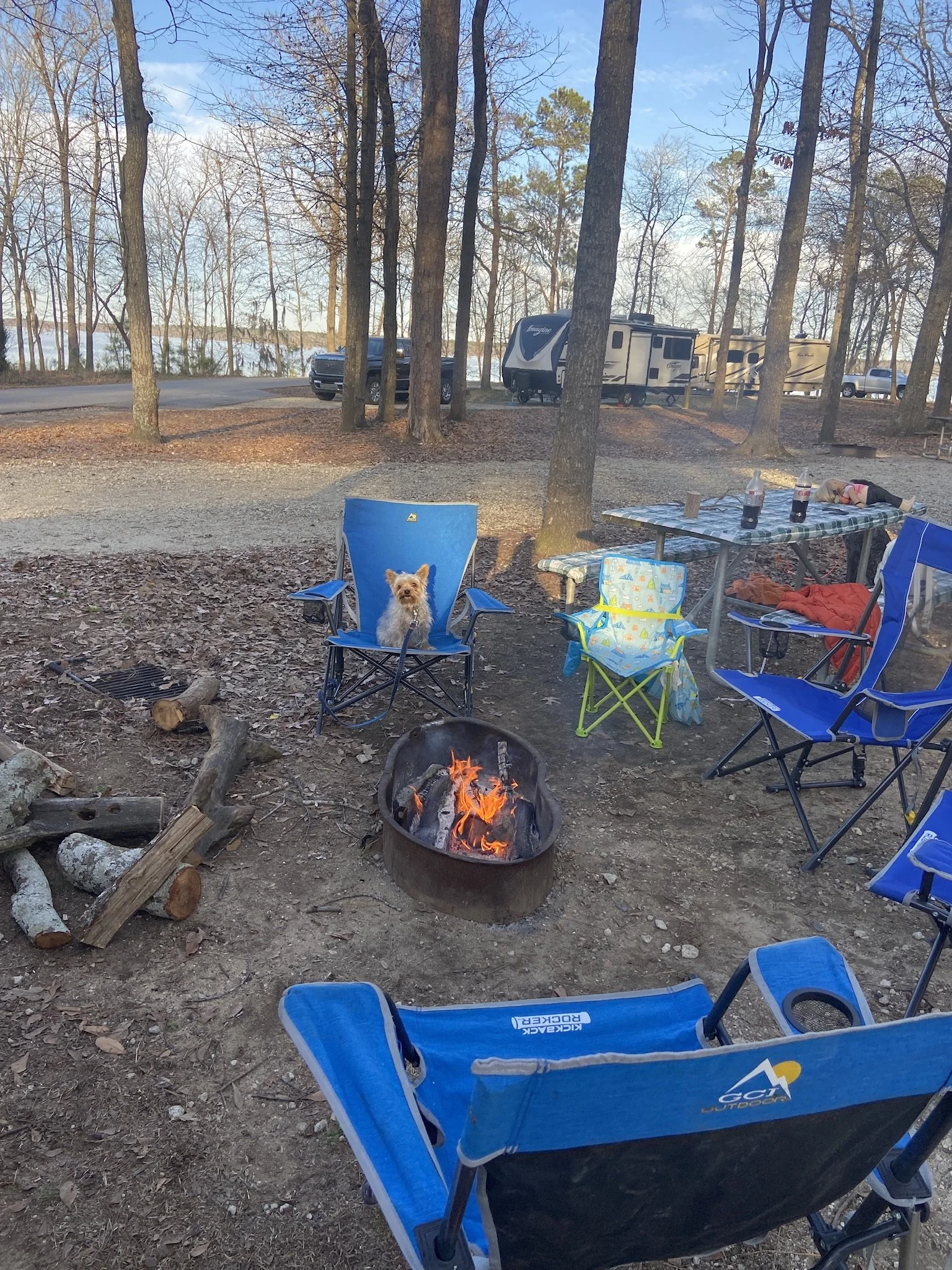How to Keep Your Dog Warm While Camping
Take your furry friend along with you, no matter the season!
We’ve got some great tips on how to keep your dog warm while camping, so everyone enjoys every moment.
We have 3 dogs, and they’re usually all along for the ride when we camp.
Just as my husband and I have to plan ahead to keep our kids comfortable on a trip, we have to consider how to do the same for our pups, too.
We’ve used the tips below both in tent camping/ car camping, and in our two campers.
PIN ME!
While a pop-up, travel trailer, or RV will provide more insulation than tent camping, we’ve had some chilly nights even in our hard sided Winnebago. (Like that time the propane went out at 4 AM when it was below freezing!)
We love fall and early spring camping, but the temperatures can be quite variable.
Assume that the temps will be lower than you expect, and plan accordingly to keep your dog warm while camping.
NOTE: As someone who’s always lived in the relatively moderate temperatures of the U.S. South, I don’t have any experience with deep snow camping.
The tips below specifically speak to temperatures we might see between November and March (usually between 25-50 degrees).
This post contains affiliates. If you choose to purchase through the links, I will receive a small commission at no charge to you.
How to Keep Your Dog Warm While Camping
Tip 1: If you’re cold, your dog probably is, too.
My husband and our Drahthaar enjoy fall camping in Cherokee, North Carolina.
While dogs’ coats do provide some natural resistance against the cold that humans don’t have, they still can—and do—get cold.
As soon as the sun goes down, I know I’m reaching for coats for the kids and myself.
That’s usually when I do the first check on the dogs as well.
The same goes for extreme heat, which we have to watch for here in the South during the spring, summer, and fall.
If you’re hot, your dog is, too.
Remember, dogs can get frostbite just like humans.
While this might take consistent and cold weather to occur, it can happen.
Tip 2: Watch for behavioral cues.
Much like humans, a dog’s tolerance for a particular temperature varies wildly.
Our Deutsch Drahthaar is comfortable well into the mid-20s before he begins to act chilled.
On the other hand, our tiny Yorkie starts shivering as soon as the sun goes down, even in the summer.
Pay attention to your dogs:
are they still moving around and interested in what you’re doing, or are they curled up in a bed of leaves?
are they looking around comfortably or staring straight ahead while shivering?
are they trying to cuddle with each other—or you—when they normally prefer to be alone?
Take precautions if you begin to notice that your dog is acting differently, or obviously shivering.
Tip 3: Have a den mentality.
Wild dogs, wolves, and other canines don’t have the luxury of humans helping them stay warm.
So, they use the best thing they have: each other.
Of my family, I am the one who is always freezing (seriously, always! I wear a sweatshirt when it’s 65 outside!).
If I’m cold, then I know my Yorkie is, too. The two of us have spent many a night cuddled together in our tent, which helps immensely.
Once we had kids, my husband and I made sure that everyone was able to sleep closely in our tent, including the dogs.
Not only are the dogs really warm, but we all feed off of one another’s body heat to stay toasty until daybreak.
Tip 4: Watch those paws.
Icy cold after jumping in a puddle (and ready for his cold weather socks) while in West Virginia
If anything is going to be affected by cold weather, it’s going to be your dogs’ paws.
Just like our feet can get burned by hot asphalt or chilled by icy walkways, your dogs’ paws can, too.
When it’s particularly chilly on your camping trip, limit your dog’s time on asphalt or other poured surfaces, as these tend to be colder than the surrounding ground.
If you have to be out in at- or below-freezing temperatures for an extended time, invest in some dog protective socks.
These little socks provide a needed barrier on your dog’s delicate paws and go a long way towards keeping them warmer.
NOTE: If your dogs are anything like mine, the protective socks will take some getting used to.
Expect some doggy performances of the Ministry of Silly Walks for the first wear or two!
Looking for some great places to go camping with your dog? Check our our guide to the best state parks in South Carolina for camping!
Tip 5: Build a nest.
In his favorite spot in the floor of the camper
Dogs don’t have a concept of cuddling into a blanket, and most will quickly wriggle out if you attempt to put them inside of a blanket like you would another human.
Instead, watch how your dog naturally curls up in a pile of leaves to learn how best to arrange a blanket for him or her.
Dogs will turn around (and around and around) when they’re settling naturally, so work with—not against—that when you’re trying to keep them warm.
Loosely pile a blanket on the floor, bed, or chair that you’d like your dog to sleep on. The dog should then “fix” the blanket into a little nest, which will ensure that he or she will stay snuggly all night long.
If, after your dog has gotten comfortable in this nest, he or she still looks cold, pull some of the blanket higher up on the dog’s sides.
Don’t attempt to cover them completely, or they may wiggle out, and you’ll have to start the process over completely.
Depending on your dog’s comfort level, you might also consider a heated blanket placed on a low level.
As mentioned before, our Yorkie has a much harder time regulating his body heat than our larger sporting dog does.
The Yorkie appreciates any blanket, but he’s particularly loved it when we’ve either pre-warmed his blanket by the fire or plugged in a heating blanket on the lowest setting for him.
Hanging out by the fire in Santee State Park in South Carolina
Tip 6: Hang out by the fire.
If you’re tent camping, and won’t have a reliable external heat source inside your sleeping area, linger by the fire as long as possible.
When we took our Winnebago Micro Minnie 1800BH out for some winter camping here in South Carolina, our Yorkie did nothing but hang out by the fire for most of the day.
He loves to cuddle up in one of our camp chairs for added warmth.
At night, the temperatures on that trip plummeted to around freezing, and we then placed the Yorkie on our laps as we sat by the fire.
This ensured that he was getting radiant heat from one of us and from the fire.
When we’re all ready to turn in, the Yorkie is already nice and toasty before he gets himself settled into his blanket in the camper.






